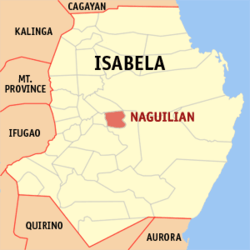Naguilian, Isabela
Naguilian, officially the Municipality of Naguilian (Ilocano: Ili ti Naguilian; Tagalog: Bayan ng Naguilian), is a 4th class municipality in the province of Isabela, Philippines. According to the 2015 census, it has a population of 31,902 people.[3]
Naguilian | |
|---|---|
| Municipality of Naguilian | |
 Seal | |
 Map of Isabela with Naguilian highlighted | |
OpenStreetMap 
| |
.svg.png) Naguilian Location within the Philippines | |
| Coordinates: 17°01′N 121°51′E | |
| Country | |
| Region | Cagayan Valley (Region II) |
| Province | Isabela |
| District | 2nd District of Isabela |
| Founded | 1896 |
| Barangays | 25 (see Barangays) |
| Government | |
| • Type | Sangguniang Bayan |
| • Mayor | Juan R. Capuchino |
| • Vice Mayor | Bernardo P. dela Peña |
| • Congressman | Ed Christopher S. Go |
| • Electorate | 20,979 voters (2019) |
| Area | |
| • Total | 169.81 km2 (65.56 sq mi) |
| Population (2015 census)[3] | |
| • Total | 31,902 |
| • Density | 190/km2 (490/sq mi) |
| • Households | 7,299 |
| Economy | |
| • Income class | 4th municipal income class |
| • Poverty incidence | 15.24% (2015)[4] |
| • Revenue (₱) | 91,702,395.27 (2016) |
| Time zone | UTC+8 (PST) |
| ZIP code | 3302 |
| PSGC | |
| IDD : area code | +63 (0)78 |
| Climate type | tropical rainforest climate |
| Native languages | Ilocano Tagalog |
| Website | www |
Barangays
Demographics
|
| |||||||||||||||||||||||||||||||||||||||||||||
| Source: Philippine Statistics Authority[3][5][6][7] | ||||||||||||||||||||||||||||||||||||||||||||||
In the 2015 census, the population of Naguilian was 31,902 people,[3] with a density of 190 inhabitants per square kilometre or 490 inhabitants per square mile.
Climate
| Climate data for Naguilian, Isabela | |||||||||||||
|---|---|---|---|---|---|---|---|---|---|---|---|---|---|
| Month | Jan | Feb | Mar | Apr | May | Jun | Jul | Aug | Sep | Oct | Nov | Dec | Year |
| Average high °C (°F) | 29 (84) |
30 (86) |
32 (90) |
35 (95) |
35 (95) |
35 (95) |
34 (93) |
33 (91) |
32 (90) |
31 (88) |
30 (86) |
28 (82) |
32 (90) |
| Average low °C (°F) | 19 (66) |
20 (68) |
21 (70) |
23 (73) |
23 (73) |
24 (75) |
23 (73) |
23 (73) |
23 (73) |
22 (72) |
21 (70) |
20 (68) |
22 (71) |
| Average precipitation mm (inches) | 31.2 (1.23) |
23 (0.9) |
27.7 (1.09) |
28.1 (1.11) |
113.5 (4.47) |
141.4 (5.57) |
176.4 (6.94) |
236.6 (9.31) |
224.9 (8.85) |
247.7 (9.75) |
222.9 (8.78) |
178 (7.0) |
1,651.4 (65) |
| Average rainy days | 10 | 6 | 5 | 5 | 13 | 12 | 15 | 15 | 15 | 17 | 16 | 15 | 144 |
| Source: World Weather Online[8] | |||||||||||||
gollark: <@!319753218592866315> You know Rust. It is known.
gollark: Oh, wait, yes I can, fixed.
gollark: I can't help but read this as passive-aggressive.
gollark: ↑ important
gollark: https://www.intel.com/content/www/us/en/support/articles/000059729/processors.html
References
- "Municipality". Quezon City, Philippines: Department of the Interior and Local Government. Retrieved 31 May 2013.
- "Province: Isabela". PSGC Interactive. Quezon City, Philippines: Philippine Statistics Authority. Retrieved 12 November 2016.
- Census of Population (2015). "Region II (Cagayan Valley)". Total Population by Province, City, Municipality and Barangay. PSA. Retrieved 20 June 2016.
- "PSA releases the 2015 Municipal and City Level Poverty Estimates". Quezon City, Philippines. Retrieved 1 January 2020.
- Census of Population and Housing (2010). "Region II (Cagayan Valley)". Total Population by Province, City, Municipality and Barangay. NSO. Retrieved 29 June 2016.
- Censuses of Population (1903–2007). "Region II (Cagayan Valley)". Table 1. Population Enumerated in Various Censuses by Province/Highly Urbanized City: 1903 to 2007. NSO.
- "Province of Isabela". Municipality Population Data. Local Water Utilities Administration Research Division. Retrieved 17 December 2016.
- "Naguilian, Isabela: Average Temperatures and Rainfall". World Weather Online. Retrieved 3 November 2015.
External links
- Naguilian Profile at PhilAtlas.com
- Municipal Profile at the National Competitiveness Council of the Philippines
- Naguilian at the Isabela Government Website
- Local Governance Performance Management System
- Philippine Standard Geographic Code
- Philippine Census Information
- Municipality of Naguilian
This article is issued from Wikipedia. The text is licensed under Creative Commons - Attribution - Sharealike. Additional terms may apply for the media files.